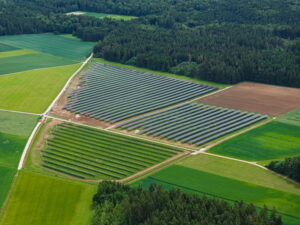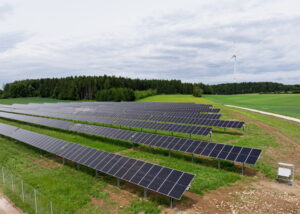 Double use, double benefit: In Veringenstadt (Baden-Württemberg, Germany), we have successfully connected our first agri-photovoltaic (Agri-PV) park featuring single-axis solar trackers to the public grid. This innovative project, with an output of 8.5 megawatt-peak (MWp), now supplies over 3,100 three-person households with climate-friendly solar power – while simultaneously allowing the land to continue being farmed.
Double use, double benefit: In Veringenstadt (Baden-Württemberg, Germany), we have successfully connected our first agri-photovoltaic (Agri-PV) park featuring single-axis solar trackers to the public grid. This innovative project, with an output of 8.5 megawatt-peak (MWp), now supplies over 3,100 three-person households with climate-friendly solar power – while simultaneously allowing the land to continue being farmed.
The Agri-PV park has been in operation since April 2025. The project was commissioned by wpd GmbH, who tasked us last year with engineering, procurement, and construction (EPC). With an annual energy yield of around 11 gigawatt-hours, the plant can supply thousands of households with renewable electricity.
![]() Technology meets practical application
Technology meets practical application
What makes this project special is the use of single-axis solar trackers with modules that can tilt between 60 and 90 degrees, enabling intelligent dual use of the land. Even after installation, farmers can continue to cultivate more than 85% of the original arable area. The trackers also provide sufficient maneuvering space for agricultural machinery, integrating seamlessly into day-to-day field operations.
“With the completion of the Agri-PV park in Veringenstadt, we are sending a strong signal for the future of renewable energy. Combining agriculture with solar power generation proves that sustainable energy and farming can go hand in hand – a real opportunity for farmers,” says Luca Becker, Project Manager for Photovoltaics at wpd.
We at IBC SOLAR are proud of this achievement:
“This is truly a milestone for agri-photovoltaics,” says Eric Herrmann, Head of EPC at IBC SOLAR. “The single-axis trackers allow the modules to be flexibly adjusted to fit agricultural use without restricting it. At the same time, we achieve high energy yields. This project demonstrates what’s possible with smart planning and innovative, high-quality components.”
The Agri-PV park in Veringenstadt showcases how sustainable energy generation and agricultural interests can be intelligently combined – a forward-looking model for the energy transition in rural areas.
